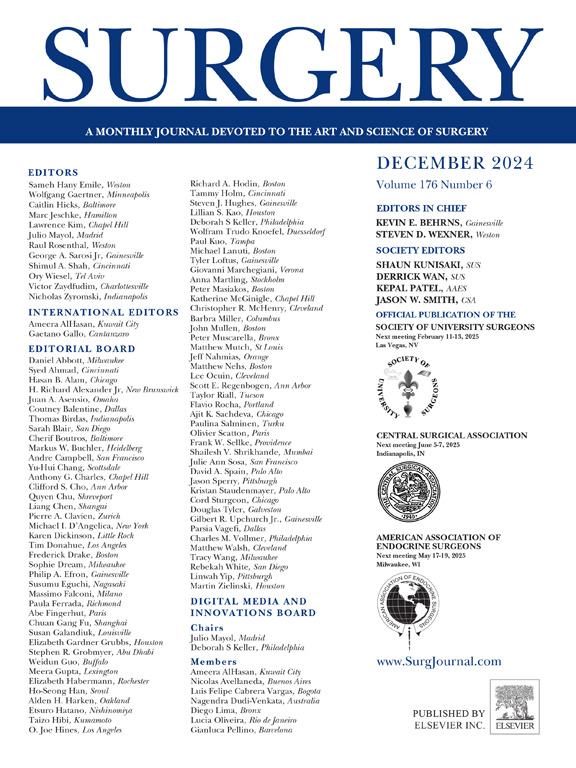基于机器学习算法的胆囊良恶性息肉术前预测模型
IF 2.7
2区 医学
Q1 SURGERY
引用次数: 0
摘要
本研究旨在利用机器学习算法建立一个综合术前经腹超声和临床特征的预测模型,以区分术前胆囊息肉的良恶性。方法回顾性分析2个中心1050例胆囊息肉切除术患者的临床及超声资料。使用六种机器学习算法建立预测良性和恶性胆囊息肉的术前模型。内部和外部测试队列评估模型的性能。Shapley Additive explained算法用于理解特征的重要性。结果主要研究队列包括660例良性息肉患者和285例恶性息肉患者,随机分为3:1分层训练组和内测组。外部测试组包括73例良性息肉和32例恶性息肉。在训练队列中,Shapley Additive Explanations算法基于最小绝对收缩和选择算子回归以及多元逻辑回归选择的变量,进一步确定了6个关键预测因素:息肉大小、年龄、纤维蛋白原、碳水化合物抗原19-9、结石存在和胆碱酯酶。利用这些因素,建立了6个预测模型。随机森林模型优于其他模型,在训练队列、内部队列和外部队列的曲线下面积分别为0.963、0.940和0.958。与以往的研究相比,随机森林模型显示出良好的临床实用性和预测性能。此外,采用Shapley加性解释算法将特征重要性可视化,并开发了在线计算平台。结论随机森林模型结合术前超声和临床特征,能准确预测胆囊息肉的良恶性,为临床决策提供有价值的指导。本文章由计算机程序翻译,如有差异,请以英文原文为准。

Preoperative prediction model for benign and malignant gallbladder polyps on the basis of machine-learning algorithms
Background
This study aimed to differentiate between benign and malignant gallbladder polyps preoperatively by developing a prediction model integrating preoperative transabdominal ultrasound and clinical features using machine-learning algorithms.
Methods
A retrospective analysis was conducted on clinical and ultrasound data from 1,050 patients at 2 centers who underwent cholecystectomy for gallbladder polyps. Six machine-learning algorithms were used to develop preoperative models for predicting benign and malignant gallbladder polyps. Internal and external test cohorts evaluated model performance. The Shapley Additive Explanations algorithm was used to understand feature importance.
Results
The main study cohort included 660 patients with benign polyps and 285 patients with malignant polyps, randomly divided into a 3:1 stratified training and internal test cohorts. The external test cohorts consisted of 73 benign and 32 malignant polyps. In the training cohort, the Shapley Additive Explanations algorithm, on the basis of variables selected by Least Absolute Shrinkage and Selection Operator regression and multivariate logistic regression, further identified 6 key predictive factors: polyp size, age, fibrinogen, carbohydrate antigen 19-9, presence of stones, and cholinesterase. Using these factors, 6 predictive models were developed. The random forest model outperformed others, with an area under the curve of 0.963, 0.940, and 0.958 in the training, internal, and external test cohorts, respectively. Compared with previous studies, the random forest model demonstrated excellent clinical utility and predictive performance. In addition, the Shapley Additive Explanations algorithm was used to visualize feature importance, and an online calculation platform was developed.
Conclusion
The random forest model, combining preoperative ultrasound and clinical features, accurately predicts benign and malignant gallbladder polyps, offering valuable guidance for clinical decision-making.
求助全文
通过发布文献求助,成功后即可免费获取论文全文。
去求助
来源期刊

Surgery
医学-外科
CiteScore
5.40
自引率
5.30%
发文量
687
审稿时长
64 days
期刊介绍:
For 66 years, Surgery has published practical, authoritative information about procedures, clinical advances, and major trends shaping general surgery. Each issue features original scientific contributions and clinical reports. Peer-reviewed articles cover topics in oncology, trauma, gastrointestinal, vascular, and transplantation surgery. The journal also publishes papers from the meetings of its sponsoring societies, the Society of University Surgeons, the Central Surgical Association, and the American Association of Endocrine Surgeons.
 求助内容:
求助内容: 应助结果提醒方式:
应助结果提醒方式:


